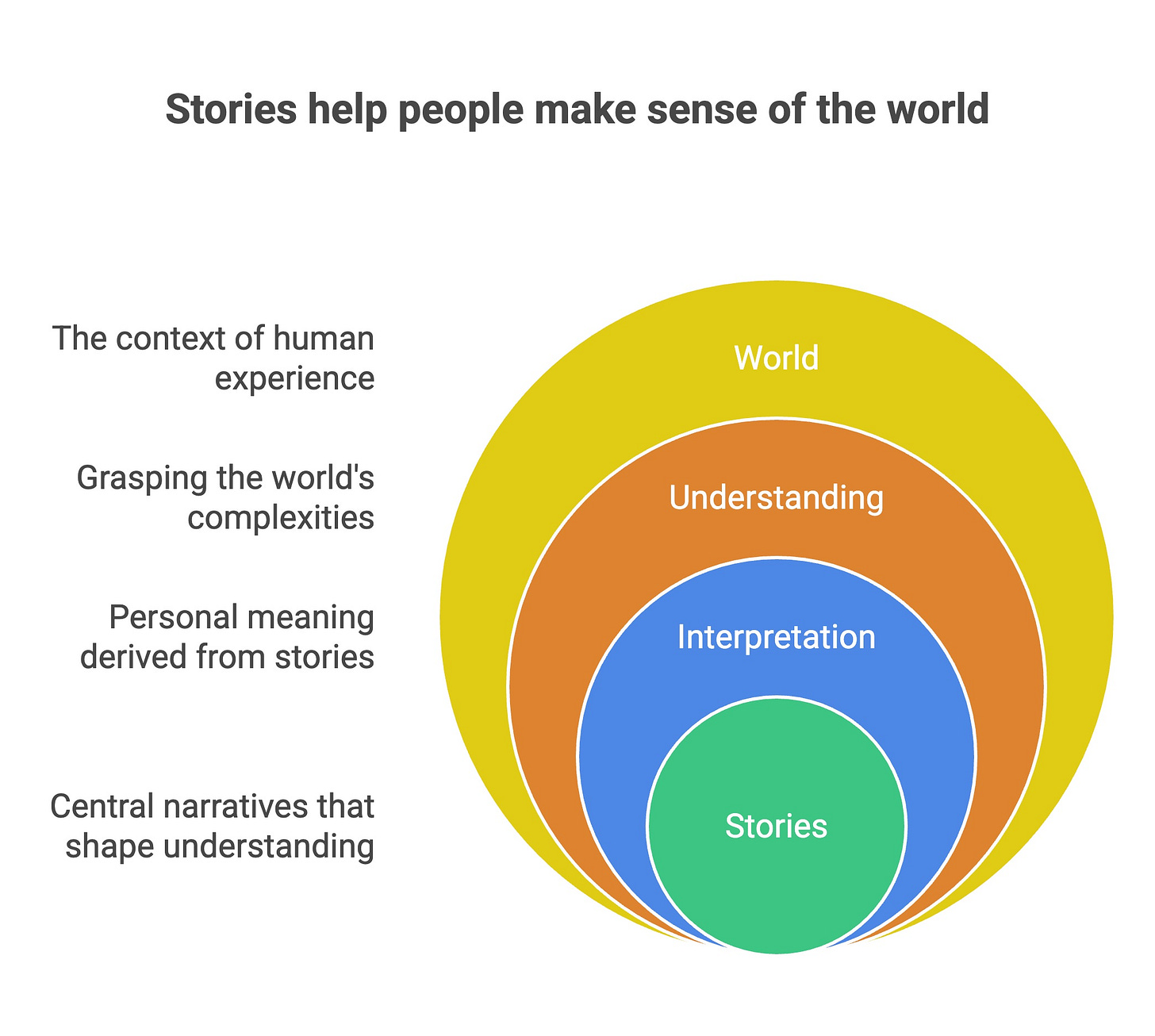Use AI to build a powerful brand story
AI won’t write your brand story for you. But it can help you find the one worth telling.
Stories are how people make sense of the world. Before we had dashboards, metrics, or marketing funnels, we had storytelling. It was the first kind of data visualization.
A story connects emotion to meaning. It turns facts into feelings people remember and repeat.
Most brands start by talking about what they do instead of what people feel. That’s where the story falls flat. AI can change that. It helps you uncover patterns, emotions, and truths that are easy to miss when you’re inside the business every day.
This is where creativity meets computation. It’s where human intuition and machine insight work together to build something that spreads.
Let’s go step-by-step.
1. Unearth Emotional Themes
Every memorable story begins with emotion. Yet most marketers stay at the surface. They talk about saving time or improving efficiency, but those aren’t emotions.
AI helps you go deeper.
Feed it your customer reviews, testimonials, surveys, and comments. Then ask:
“Scan this customer feedback and identify recurring emotions, words, and phrases that reflect why people buy, stay, or recommend our brand.”
AI can find patterns like relief, confidence, hope, belonging, or trust. These aren’t just feelings. They’re clues to what your story is really about.
Once you spot the themes, summarize each one with:
Emotion: what customers feel
Customer quote: how they express it
Brand opportunity: how you can amplify that feeling
Then, ask AI to translate those emotions into story archetypes like the guide, the liberator, the connector. This helps shape your brand’s tone and visuals later on.
2. Make the Customer the Hero
Your brand is not the main character. Your customer is. You are the guide who helps them transform.
AI can help you map out the customer’s journey from struggle to success. Try this:
“Turn this customer story into a transformation arc. Show where they started, what they struggled with, what shifted, and how they changed.”
You’ll begin to see patterns such as:
Before: “I felt lost.” After: “Now I finally feel capable.”
Before: “I didn’t believe I could do it.” After: “I’m proud of what I’ve built.”
These are human stories, not sales copy. They build trust and spark recognition.
You can also ask AI to group stories by theme, such as empowerment, simplicity, or belonging. This helps you tailor the right message to each audience segment.
3. Test the Retell Factor
The best stories aren’t just understood. They’re retold.
To test if your story is memorable, ask:
“Rewrite our brand story as if a loyal customer were explaining it to a friend over coffee.”
If it sounds natural and easy to repeat, you’re on the right track.
If it sounds stiff or overly polished, simplify.
You can go further and ask AI to simulate how different audiences might tell it: a Gen Z shopper, a parent, or a small business owner. Pay attention to the phrases that repeat across versions. Those are the sticky ones that spread.
Look for one-liners or metaphors that stand out. They often become your tagline or brand promise.
4. Carry the Story Across the Funnel
A brand story shouldn’t live on one page of your website. It should flow through every stage of the customer journey.
Here’s how to translate your story across the funnel.
Awareness – Tell Your Origin
Share your “why.” What inspired you to create your brand?
Prompt:
“Write our brand origin story highlighting our mission and the problem we set out to solve.”
Consideration – Show Real Transformation
Let customers see themselves in the story. Use testimonials and success examples.
Prompt:
“Turn our customer case studies into short emotional transformation stories with a clear before and after.”
Conversion – Pair Emotion with Proof
At this stage, combine emotion with evidence. Data, reviews, and visuals all work together.
Prompt:
“Write a paragraph for our landing page that connects emotional benefits with logical proof.”
Retention – Reinforce Shared Values
Remind your customers why they chose you. Build community around shared beliefs.
Prompt:
“Write a short community update that reinforces our shared mission and celebrates our customers.”
For your own clarity, ask AI to map how each part of the funnel ties back to one core emotion, such as confidence or belonging. This keeps your storytelling consistent everywhere.
5. Measure Resonance
After your story goes out, see what’s connecting.
AI can help here too.
Prompt example:
“Analyze these social comments and reviews to identify which emotions or topics received the strongest reactions.”
You might learn that stories about community get shared the most, or that transformation stories spark long comment threads.
You can use tools like ChatGPT, Brandwatch, or Talkwalker to track emotional keywords such as finally, peace, freedom, proud. These words signal what your audience truly cares about.
When you listen closely, the data tells you what to amplify next.
6. When Emotion Meets Data, Storytelling Scales
Data without story is just numbers. Story without data is just nostalgia.
AI helps you bring the two together. It translates emotion into insight and insight into creative strategy.
Use AI to:
Identify which storylines drive the most engagement.
Find audience segments who connect with certain emotional tones.
Adjust your messaging as you learn what resonates.
This is storytelling that grows with you. It evolves with your audience instead of staying static.
Try this:
“Based on this month’s campaign results, which emotional themes drove the strongest engagement? Suggest three new story angles to test next month.”
When you merge empathy and evidence, you move from storytelling to story intelligence.
7. AI Sharpens Your Story, But You Make It Human
AI can analyze patterns and emotions, but it doesn’t know your heart. It doesn’t know what it felt like to take your first risk, win your first customer, or stay up late trying to make something better.
That’s your job.
AI helps you organize your insights and amplify your message. But only you can infuse it with honesty and warmth.
The best stories are co-written by three forces: you, your customers, and the insights AI helps you uncover.
Try This Prompt
“Act as a brand strategist. I’ll share my mission statement and 10 customer reviews. Identify the emotional thread that connects them, then write a one-paragraph brand story that makes my customer the hero.”
You’ll finish with something emotionally powerful, data-informed, and completely your own.
Final Thought
When you use AI to uncover the feelings behind your data, you stop guessing what matters to people. You start seeing it.
That’s when your story spreads naturally.
Not because it’s loud, but because it’s real.
The stories worth telling are the ones your customers can’t stop repeating.




